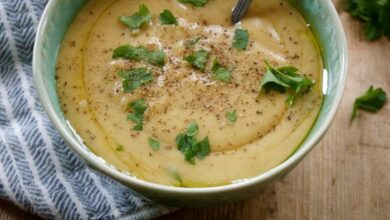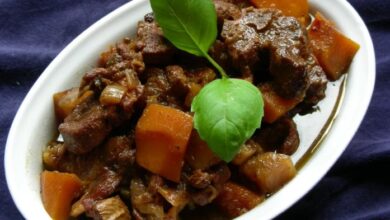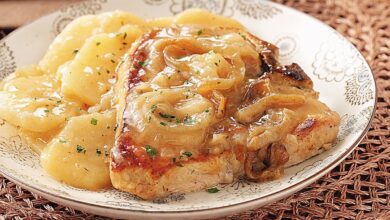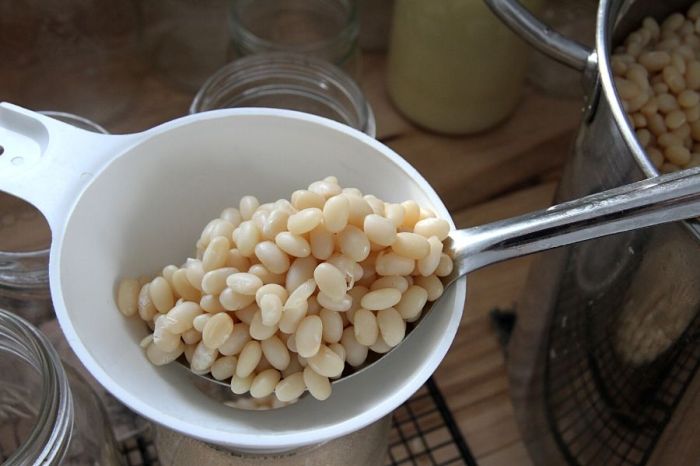
Down Home Baked Beans: A Taste of Tradition
Down home baked beans are more than just a dish; they are a culinary tradition that speaks to the heart of home cooking and comfort food. From humble beginnings, baked beans have evolved into a beloved staple across various cultures, each region adding its own unique twist to this classic recipe.
The aroma of slow-cooked beans, infused with the sweet and smoky notes of molasses and spices, is a comforting scent that evokes memories of family gatherings and shared meals.
This exploration delves into the rich history and cultural significance of down home baked beans, tracing their journey from humble beginnings to their present-day popularity. We’ll uncover the secrets behind their distinct flavor profiles, exploring the different ingredients and preparation methods that have made them a culinary treasure.
Join us as we savor the diverse regional variations, discover the perfect accompaniments, and delve into the nutritional value and health benefits of this beloved dish.
History and Origins
Baked beans, a dish deeply rooted in history and tradition, have a fascinating journey that spans continents and centuries. Their origins can be traced back to ancient times, evolving over the years to become a beloved comfort food across the globe.
Origins of Baked Beans
The origins of baked beans can be traced back to ancient civilizations. Evidence suggests that beans were cultivated in the Americas as early as 7,000 years ago, and they were a staple food for indigenous populations. The early European settlers in North America learned about beans from Native Americans and incorporated them into their diet.
Evolution of Baked Beans Recipes
The traditional baked beans recipe has evolved over time, with variations arising from different cultures and regions. In the early days, baked beans were typically cooked in a simple manner, with only a few ingredients such as molasses, salt, and spices.
- Early American Recipes:Early American recipes often included ingredients like molasses, salt, pork fat, and spices. These recipes were influenced by the availability of ingredients and the cooking methods of the time.
- Regional Variations:Over time, regional variations in baked beans emerged. For example, New England baked beans are known for their sweet and savory flavors, while Southern baked beans are often cooked with bacon or ham.
- Modern Innovations:In modern times, baked beans have become increasingly sophisticated, with chefs experimenting with new flavors and ingredients. Some popular variations include baked beans with barbecue sauce, chili, or even exotic spices.
Cultural Significance
Baked beans hold a special place in many cultures. In the United States, baked beans are often associated with picnics, barbecues, and other outdoor gatherings. They are also a popular side dish served with breakfast, lunch, or dinner.
- American Cuisine:Baked beans are considered a quintessential American dish, often served at cookouts and sporting events.
- British Cuisine:In the United Kingdom, baked beans are typically served on toast or with sausages, and they are often enjoyed for breakfast or brunch.
- Global Influence:Baked beans have also found their way into cuisines around the world, with variations often reflecting local ingredients and cooking styles.
Historical Anecdotes
There are many historical anecdotes and stories related to down-home baked beans. One popular story tells of the origin of the “Boston baked bean” recipe, which is said to have been developed by a group of Bostonian housewives who were looking for a way to use up leftover beans.
“The Boston baked bean is a dish that is steeped in history and tradition. It is said to have originated in the early days of the American colonies, when housewives would often use up leftover beans by baking them with molasses, salt, and spices.”
Another interesting anecdote relates to the use of baked beans as a source of sustenance during the American Civil War. Soldiers on both sides of the conflict relied on baked beans for their nutritional value and ease of preparation.
“During the American Civil War, baked beans were a staple food for soldiers on both sides of the conflict. They were a good source of protein and fiber, and they were easy to prepare in the field.”
Ingredients and Preparation
Down-home baked beans are a classic comfort food that’s both simple and versatile. While the exact ingredients and preparation methods can vary based on family recipes and regional preferences, there are some key elements that contribute to the dish’s signature flavor and texture.
Ingredients, Down home baked beans
The foundation of any good baked bean recipe lies in the quality of its ingredients. Here’s a typical list of ingredients used in down-home baked beans:
- Dry beans:The most common bean used in baked beans is the navy bean, known for its creamy texture and mild flavor. Other beans like kidney beans, pinto beans, or black beanscan also be used to add variety and depth to the flavor profile.
- Liquid:Water or broth forms the base of the beans, providing the necessary liquid for cooking. For added depth of flavor, some recipes call for chicken broth, beef broth, or even beer.
- Sweeteners:Molasses and brown sugar are key ingredients that impart the characteristic sweet and savory flavor profile of baked beans. Molasses adds a rich, complex sweetness, while brown sugar contributes a milder sweetness and a hint of caramel notes.
- Spices:Spices play a crucial role in enhancing the flavor of baked beans. Common spices include salt, black pepper, mustard, onion powder, garlic powder, paprika, and cayenne pepper.
- Optional additions:Many recipes incorporate additional ingredients for extra flavor and texture. These can include chopped onions, bacon, ham, pork, mustard, ketchup, or even vinegar.
Preparation Methods
There are several methods for preparing down-home baked beans, each with its own unique advantages:
Slow Cooking
Slow cooking is a popular method for making baked beans, as it allows the flavors to meld and develop over a long period. This method is ideal for creating a tender, creamy texture. Here’s how it works:
- Soak the beans:Soaking the beans overnight helps to reduce cooking time and improve their texture. This step is not always necessary, but it’s recommended for drier beans.
- Combine ingredients:Combine the soaked beans with the liquid, sweeteners, spices, and any optional ingredients in a slow cooker.
- Cook on low:Cook the beans on low heat for 6-8 hours, or until they are tender and the flavors have developed.
- Adjust seasoning:Taste the beans and adjust the seasoning as needed.
Pressure Cooking
Pressure cooking is a faster method for preparing baked beans, allowing you to achieve tender beans in a shorter time. However, this method can sometimes result in a slightly less creamy texture.
- Combine ingredients:Combine the beans, liquid, sweeteners, spices, and optional ingredients in a pressure cooker.
- Cook under pressure:Cook the beans under pressure for 30-45 minutes, or until tender.
- Release pressure:Allow the pressure to release naturally before opening the cooker.
- Adjust seasoning:Taste the beans and adjust the seasoning as needed.
Oven Baking
Oven baking is another method for preparing baked beans, which can produce a crispy top layer and a rich, caramelized flavor.
- Combine ingredients:Combine the beans, liquid, sweeteners, spices, and optional ingredients in a baking dish.
- Bake in the oven:Bake the beans in a preheated oven at 350°F (175°C) for 1-2 hours, or until tender and the top is slightly browned.
- Adjust seasoning:Taste the beans and adjust the seasoning as needed.
Flavor Profile
Molasses, brown sugar, and spices play a significant role in shaping the distinct flavor profile of down-home baked beans:
Molasses:The rich, complex sweetness of molasses adds depth and a hint of bitterness, creating a balance between sweet and savory flavors.
Brown sugar:Brown sugar contributes a milder sweetness and a hint of caramel notes, complementing the molasses and adding a touch of warmth to the overall flavor.
There’s something so comforting about a pot of down home baked beans simmering on the stove, the aroma filling the house with warmth. It reminds me of family gatherings and simple pleasures. But sometimes, you crave something a little different, like the tangy sweetness of chinese sweet and sour chicken.
It’s a fun and flavorful contrast to the hearty beans, and the combination of sweet and savory is always a winner. But when it comes down to it, nothing beats the classic comfort of those down home baked beans.
Spices:Spices enhance the flavor profile by adding warmth, depth, and complexity. The specific combination of spices used can vary based on regional preferences and personal taste.
Regional Variations
Baked beans, a staple in many American households, come in a wide variety of regional styles, each with its own unique flavor profile and preparation methods. These regional variations reflect the diverse culinary traditions and local ingredients found across the country.
New England Baked Beans
New England baked beans are perhaps the most iconic style of baked beans in the United States. They are typically slow-cooked in a Dutch oven or bean pot with molasses, salt pork, and onions. The molasses adds a distinctive sweetness, while the salt pork provides a savory depth of flavor.
The beans are often served with brown bread, which complements the sweetness of the beans.
Boston Baked Beans
Boston baked beans, a specific variation of New England baked beans, are known for their rich, dark molasses flavor. They are typically cooked with a generous amount of molasses, creating a deep, syrupy sauce that coats the beans. Boston baked beans are often served with mustard and a side of coleslaw.
Southern Baked Beans
Southern baked beans are often made with a combination of molasses, brown sugar, and bacon. They are typically cooked in a slow cooker or oven, allowing the flavors to meld together. Southern baked beans are often served with barbecue sauce, which adds a smoky and tangy flavor.
Texas Baked Beans
Texas baked beans are known for their bold, spicy flavor. They are typically cooked with chili powder, cumin, and other spices, creating a smoky and savory taste. Texas baked beans are often served with chili, barbecue, or other Southwestern dishes.
California Baked Beans
California baked beans often feature a more modern twist, incorporating ingredients such as jalapenos, corn, and other Southwestern flavors. They are typically cooked with a lighter sauce, making them a lighter and more refreshing option. California baked beans are often served with tacos, burritos, or other Mexican-inspired dishes.
Serving and Accompaniments
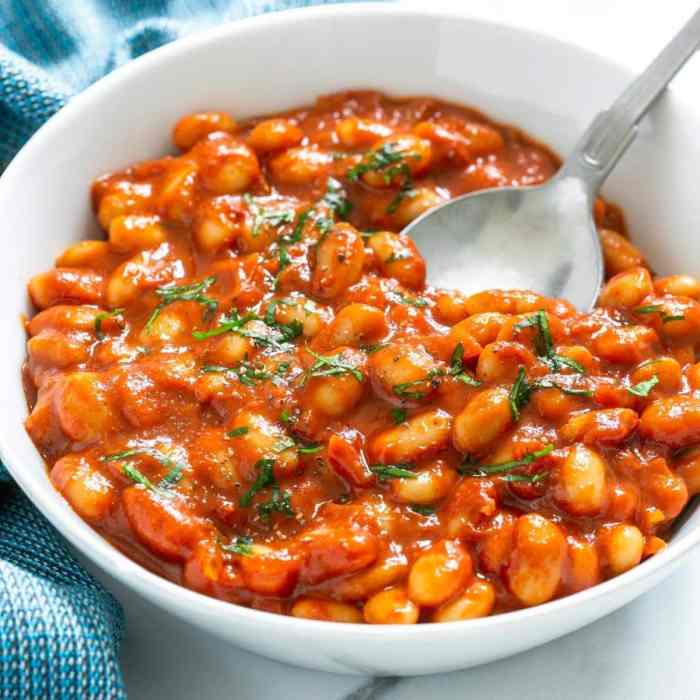
Down-home baked beans, a culinary staple in many American households, are traditionally served in a variety of ways, often reflecting regional preferences and family traditions. From classic pairings to innovative combinations, the versatility of baked beans allows for countless serving options, making them a beloved dish for meals and gatherings alike.
Common Serving Methods
Baked beans are often served hot, straight from the oven or slow cooker. A common practice is to ladle them into bowls, often alongside a generous dollop of butter or a drizzle of molasses. The warm, comforting flavors of the beans are enhanced by the addition of these toppings.
There’s something about down home baked beans that just screams comfort food. The sweet and smoky flavors, the tender beans, the perfect side dish for any barbecue. Speaking of barbecue, you know what else pairs perfectly with baked beans?
My favorite grilled chicken ever , with its crispy skin and juicy meat. Now, I’m not saying you need to grill chicken every time you have baked beans, but it’s definitely a winning combination!
Traditional Accompaniments
Baked beans are typically enjoyed as part of a larger meal, with a range of accompaniments that complement their hearty flavor. Some popular side dishes include:
- Cornbread:A classic pairing that provides a sweet and crumbly contrast to the savory beans.
- Potato Salad:A creamy and refreshing counterpoint to the richness of the beans.
- Cole Slaw:A crunchy and tangy side dish that adds a bright and refreshing element to the meal.
- Fried Chicken:A quintessential Southern combination that offers a crispy and flavorful counterpoint to the soft beans.
- Grilled Sausage:A savory and smoky addition that complements the beans’ rich flavor.
Baked Beans in Different Meals and Occasions
Baked beans are a versatile dish that can be enjoyed in various meal contexts:
- Barbecue:Baked beans are a staple at barbecue gatherings, often served alongside pulled pork, ribs, and other smoked meats.
- Picnics:Their portability and ease of preparation make baked beans an ideal dish for picnics and outdoor events.
- Potlucks:Baked beans are a popular contribution to potlucks, as they are typically made in large quantities and are always a crowd-pleaser.
- Weeknight Dinners:Baked beans can be a comforting and satisfying weeknight meal, especially when paired with simple sides like salad or bread.
Cultural Significance and Traditions

Down-home baked beans are more than just a delicious dish; they hold a special place in the hearts and kitchens of many communities, reflecting a rich tapestry of cultural traditions and shared experiences. Baked beans are a symbol of comfort, nostalgia, and connection, transcending generations and bringing people together.
Family Recipes and Potlucks
Family recipes are often passed down through generations, each variation reflecting the unique tastes and preferences of a particular family. These recipes are not just about the ingredients; they are about the stories and memories associated with them. They represent a link to the past, a connection to family history, and a sense of belonging.Baked beans are also a staple at potlucks and community gatherings.
They are a dish that everyone enjoys, making them perfect for bringing people together. The act of sharing a meal, especially one as comforting and familiar as baked beans, fosters a sense of community and strengthens bonds.
Community Gatherings and Celebrations
Baked beans have long been a part of community gatherings and celebrations, from church picnics and family reunions to sporting events and festivals. Their versatility makes them suitable for any occasion, from casual backyard barbecues to more formal events.In many communities, baked beans are a symbol of hospitality and generosity.
They are often served alongside other down-home favorites, creating a feast that reflects the warmth and welcoming nature of the community.
There’s something so comforting about a big pot of down home baked beans, simmering on the stove all day. It reminds me of simpler times, and the smell alone is enough to make you feel warm and fuzzy inside. Of course, if you’re looking for a lighter, more delicate flavor, you might try a bowl of miso soup with shiitake mushrooms.
It’s a delicious and healthy option, and the umami richness of the broth is surprisingly satisfying. But for a truly soul-warming meal, you can’t beat a good old-fashioned pot of baked beans.
Nutritional Value and Health Benefits
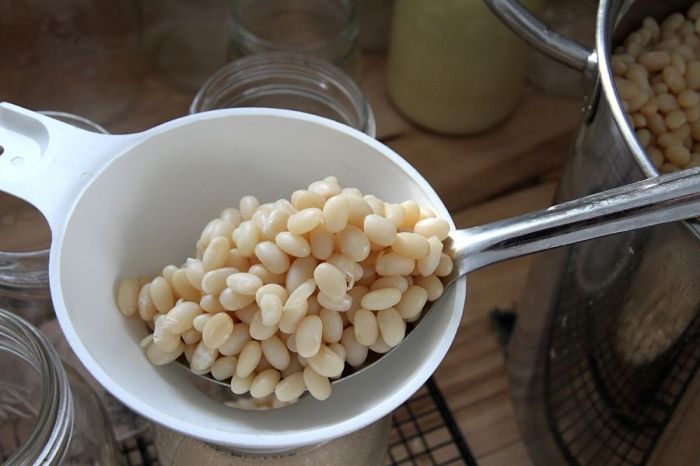
Baked beans are a nutritious and versatile food that can be enjoyed as part of a balanced diet. They are a good source of several essential nutrients, including protein, fiber, and vitamins. Baked beans are also relatively low in calories and fat, making them a healthy and satisfying choice for a meal or snack.
Nutritional Content
Baked beans are a good source of several essential nutrients, including:
- Protein:A half-cup serving of baked beans provides about 7 grams of protein, which is essential for building and repairing tissues.
- Fiber:Baked beans are high in fiber, with a half-cup serving providing about 6 grams. Fiber is important for digestive health, helping to regulate bowel movements and prevent constipation.
- Vitamins:Baked beans are a good source of several vitamins, including thiamin, riboflavin, niacin, and folate. These vitamins are important for energy production, cell growth, and overall health.
- Minerals:Baked beans also contain several essential minerals, including iron, potassium, and magnesium. Iron is important for carrying oxygen throughout the body, potassium helps to regulate blood pressure, and magnesium is involved in over 300 biochemical reactions in the body.
Health Benefits
The nutritional content of baked beans provides a range of potential health benefits, including:
- Improved Digestive Health:The high fiber content of baked beans can help to improve digestive health by promoting regular bowel movements and preventing constipation.
- Reduced Risk of Chronic Diseases:Studies have shown that a diet rich in fiber, such as that found in baked beans, may help to reduce the risk of developing chronic diseases, such as heart disease, type 2 diabetes, and some types of cancer.
- Weight Management:Baked beans are relatively low in calories and fat, making them a good choice for weight management. The high fiber content can also help to promote feelings of fullness, which can help to reduce overall calorie intake.
Making Baked Beans Healthier
There are several ways to make baked beans a healthier option, including:
- Choose Low-Sodium Varieties:Many baked beans are high in sodium, which can contribute to high blood pressure. Look for low-sodium varieties or make your own baked beans at home, using less salt.
- Add More Vegetables:Baked beans are a great base for adding more vegetables, such as onions, peppers, and carrots. This will add extra nutrients and flavor to your dish.
- Use a Healthier Cooking Method:Baked beans can be cooked in a variety of ways, including baking, simmering, or slow-cooking. Choose healthier cooking methods, such as baking or simmering, to reduce the amount of fat and calories in your dish.
Modern Interpretations and Innovations: Down Home Baked Beans
The traditional baked bean recipe, while beloved for its classic flavors, has inspired countless modern variations and reinterpretations. Chefs and home cooks alike have embraced the versatility of baked beans, experimenting with new ingredients, cooking techniques, and flavor profiles to create exciting and innovative dishes.
These modern interpretations not only pay homage to the original recipe but also showcase the adaptability of this humble comfort food.
Flavor Explorations
Modern interpretations of baked beans often explore new flavor profiles by incorporating ingredients from different cuisines and culinary traditions. This trend is driven by a growing interest in global flavors and the desire to create dishes that are both familiar and exciting.
- Asian-Inspired Baked Beans:Chefs are incorporating Asian ingredients like soy sauce, ginger, and sesame oil to create savory and umami-rich baked beans. For example, a recipe might combine traditional baked beans with a sweet and spicy Korean gochujang sauce, resulting in a dish that is both comforting and bold.
- Mediterranean Baked Beans:The Mediterranean diet, known for its emphasis on fresh vegetables, herbs, and olive oil, has also influenced baked bean recipes. Chefs are adding ingredients like Kalamata olives, sun-dried tomatoes, and oregano to create baked beans with a vibrant and earthy flavor profile.
- Smoked and Spicy Baked Beans:For those who prefer a more robust flavor, smoked paprika, chipotle peppers, and other smoky and spicy ingredients are being used to add depth and complexity to baked beans. These variations often incorporate smoked meats like bacon or brisket, further enhancing the smoky flavor.
Innovative Techniques
Beyond flavor, modern interpretations of baked beans are also exploring new cooking techniques and presentation styles. These innovations aim to elevate the traditional dish and create a more refined and visually appealing experience.
- Sous Vide Baked Beans:Sous vide cooking, a technique that involves immersing food in a temperature-controlled water bath, is being used to create baked beans with a more consistent texture and deeper flavor. The precise temperature control ensures that the beans are cooked evenly and the flavors are fully developed.
- Smoked Baked Beans:Using a smoker to cook baked beans adds a unique smoky flavor that is not achievable with traditional oven cooking. This technique is often used in conjunction with other ingredients like smoked meats and wood chips to enhance the smoky flavor profile.
- Gourmet Presentation:Modern interpretations of baked beans are often presented in creative and visually appealing ways. For example, baked beans might be served in individual ramekins, topped with a dollop of sour cream or crème fraîche, and garnished with fresh herbs. This elevated presentation elevates the dish and makes it more suitable for special occasions.
The Future of Baked Beans
The future of down-home baked beans is likely to be shaped by a continued exploration of new flavors, techniques, and presentation styles. As consumers become more adventurous in their culinary choices, we can expect to see even more innovative and exciting interpretations of this classic dish.
The future of baked beans is bright, with endless possibilities for chefs and home cooks to explore and create their own unique variations.



